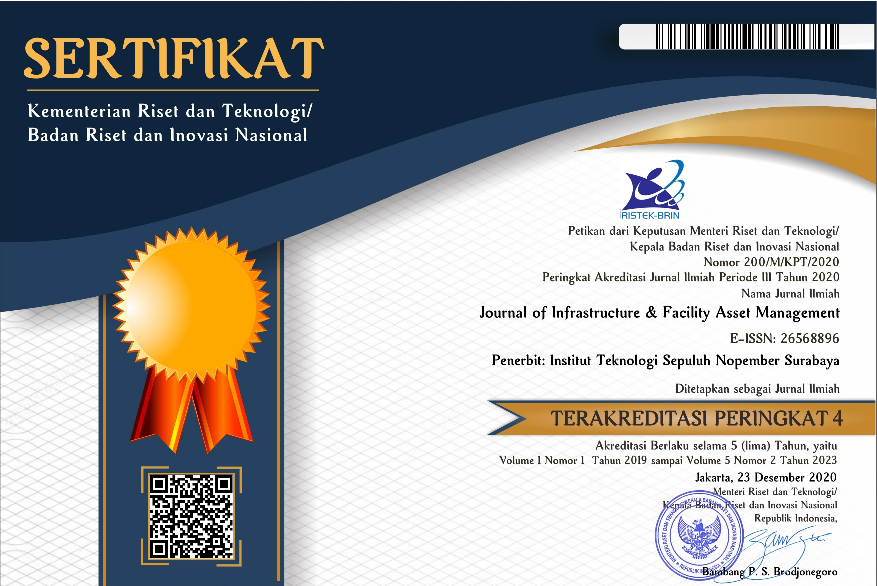Parametric Study of Embankment Stability And Geotextile Reinforcement On Soft Soil
Abstract
The Semarang - Demak Toll Road Construction Project Section 1B has a length of 6.736 km, starting from STA. 1+578 to 8+314. There is a zone that has the highest embankment, namely zone N at STA. 4+200 to 4+600. However, based on soil investigation data, it is known that the Semarang - Demak Toll Road Construction Project Section 1B has a very thick compressible layer, which reaches a depth of 50 m. This makes the Semarang - Demak Toll Road Construction Project Section 1B face various challenges of construction on soft soil.
The purpose of this research is to determine the Safety Factor (SF) value and the appropriate configuration of geotextile reinforcement requirements in an embankment with variations in compressible layer thickness, embankment height and embankment slope, especially in the case study of zone N with STA. 4+200 - 4+600. This research will be processed using the Limit Equilibrium Method (LEM) with the GEO5 auxiliary program.
Based on the results in this study, it is known that the variation of compressible layer thickness does not have a significant influence on the calculation of the Safety Factor and geotextile reinforcement configuration. However, the variation of embankment height leads to the conclusion that the higher the embankment, the lower the Safety Factor. The variation of embankment slope also concluded that the steeper the embankment, the lower the Safety Factor. In addition, it is also known that the higher the embankment, the higher the number of geotextile reinforcement requirements and the steeper the embankment, the higher the number of geotextile reinforcement requirements. After making a nomogram of the relationship between these variations and implementing it on the case study, it is known that the embankment in Zone N of the Semarang - Demak Toll Road Construction Project Section 1B has a Safety Factor value of 0.42 and requires 33 layers of geotextile reinforcement with a tensile strength of 200 kN/m, a spacing of 25 cm between layers, and a Reduction Factor value of 1.65.
Full Text:
PDFReferences
Abramson, L., Lee, T., Sharma, S., & Boyce, G. (2001). Slope Stability and Stabilization Methods. United States of America.
Ardana, M.D., Mochtar, I.B., (1999). Pengaruh Tegangan Overburden Efektif dan Plastisitas Tanah terhadap Kekuatan Geser Undrained Tanah Lempung Berkonsistensi Sangat Lunak Sampai Kaku yang Terkonsolidasi Normal. Jurusan Teknik Sipil FTSP – ITS. Surabaya.
SNI 8460 (2017). Persyaratan Perancangan Geoteknik. Badan Standarisasi Nasional. Jakarta.
Badan Geologi. (2019). Atlas Sebaran Tanah Lunak Indonesia. Kementerian Energi dan Sumber Daya Mineral. Jakarta.
Das, B. M. (1993). Mekanika Tanah, Prinsip – Prinsip Rekayasa Geoteknis, Jilid 1. Erlangga. Jakarta.
Das, B. M. (1993). Mekanika Tanah, Prinsip – Prinsip Rekayasa Geoteknis, Jilid 2. Erlangga. Jakarta.
Direktorat Jenderal Bina Marga. (2009). Perencanaan dan Pelaksanaan Perkuatan Tanah Dengan Geosintetik. Kementerian Pekerjaan Umum dan Perumahan Rakyat. Jakarta.
Fitri, S. N., Wahyuni, F. (2022). Safety Factors Investigation Based on FEM and LEM Approach in Toll Road Embankment Slope. Civil Engineering and Architecture 10(5): 1948-1966, 2022.
Harabinová, S., Panulinová, E. (2020). Impact Of Shear Strength Parameters On Slope Stability. MATEC Web of Conferences 310, 00040.
Hardiyatmo, G. C. (2002). Mekanika Tanah Jilid 1. Gajah Mada University Press. Yogyakarta.
Hastuty, I. P., Roesyanto, Manulang, A. (2018). Analysis Of The Soil Reinforcement By Using Geotextile On The Pile Of Medan – Kualanamu Of Highway Project (STA 35 + 901) With The Finite Element Method. IOP Conf. Series: Materials Science and Engineering 308 (2018) 012009.
Hoek, E., & Bray, J. (1981). Rock Slope Engineering: Third Edition. The Institution of Mining and Metallurgy. London.
Mardian D., Mochtar I. B., Mardiansyah, D. (2024). “Comparison of Three Embankment Reinforcement on Soft Soil, A Case Study of Calang – Simpang Peut Road Section”. Journal of Infrastructure and Facility Asset Management – Vol. 6, Special Issue.
Pratama, R. T., Sarie, F., Hendrie, O. (2021). “Analisis Perbaikan Tanah Menggunakan Geotekstil Pada Lapisan Subgrade Proyek Pekerjaan Jalan (Studi Kasus: Peningkatan Jalan G.Obos XXIV Kota Palangka Raya)”. Jurnal teknika Volume 4, No. 2, April 2021: 148 – 154.
Shoffiana, N. A., Lastiasih Y., Satrya T. R. (2022). “Comparison of Embankment Reinforcement Requirements with Geotextile on Soft Soil with 2D and 3D Slope Stability Analysis Methods”. Journal of Infrastructure and Facility Asset Management – Volume 4, Issue 2, August 2022.
Vashi, D. Desai A., Solanki, C. Sundararaman, B.V., (2020). Comparison of Factor of Safety between LEM and FEM for Geotextile Reinforced Embankment on Difficult Foundation. Proceedings of Indian Geotechnical Conference 2020.
Wulandari, P. S., Tjandra, D. (2015). Analysis of Geotextile Reinforced Road Embankment Using PLAXIS 2D. Procedia Engineering 125 ( 2015 ) 358 – 362.
DOI: http://dx.doi.org/10.12962%2Fjifam.v7i1.22414
Refbacks
- There are currently no refbacks.
Visitor :
Flag Counter

Journal Of Infrastructure & Facility Asset Management by Institut Teknologi Sepuluh Nopember is licensed under a Creative Commons Attribution-ShareAlike 4.0 International License.
http://earthlearning.unimol.it/
Kementerian Pemberdayaan Perempuan dan Perlindungan Anak Indonesia
BRIN - Badan Riset dan Inovasi Nasional
https://www.cityofnorthfield.org/
Website Resmi Bogor TimurIndonesia
TabolakkabResmi Kabupaten Konawe Selatan
Rumah Pangan KitaDistribusi Pangan Resmi Peluang Usaha Modal Terjangkau
Direktorat Jenderal PajakTerkini Dan Terpercaya
Kabupaten MadiunIndonesia
Rumah Sakit Umum Kabupaten KendalMasyarakat Selalu Hidup Sehat Dan Bahagia
Kadin SumateraSistem Informasi Kamar Dagang Industri Indonesia
Kadin Sumatera SelatanSistem Informasi Kamar Dagang Industri Indonesia
k
Kota DemakTerkini Dan Terbaru Hari Ini
Berita Kota MadiunTerkini dan Terbaru Hari ini
RS UIUniversitas Indonesia
Rumah Sakit Umum RSUD CicalengkaProvinsi Jawa Barat
Children's NationalHospital - Ranked Top 10 in the Nation
Murni Teguh Memorial HospitalKota Jakarta
Mayo ClinicRochester,Minnesota
RS PersahabatanKota Jakarta Timur
RS Adam Malik MedanTerjangkau, Efisien, Nyaman
(RSUD) Dr. Dradjat PrawiranegaraKabupaten Serang
https://kemkespapuaselatan.id/
https://kemkespapuapegunungan.id/
https://kemkesbengkuluprov.id/
BMKG - Badan Meteorologi, Klimatologi, dan Geofisika Indonesia





